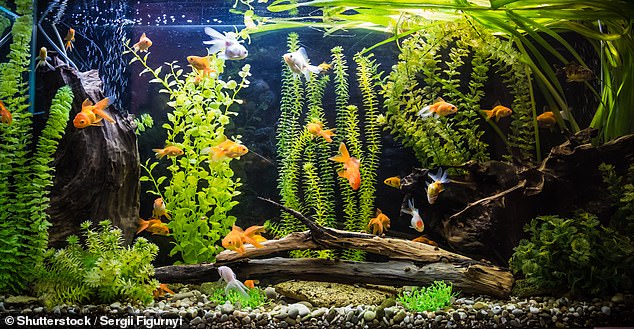Having a tank of tropical fish could contribute as much greenhouse gas as driving for thousands of miles, study finds
- Biggest environmental factors include heating the water and country of origin
- An average tropical aquarium produces 85.3 – 635.2 kg of CO2 per year
Keeping a tank of tropical fish could contribute as much greenhouse gas as driving thousands of miles in a car or a motorbike, a study has found.
The carbon footprint and environmental impacts of keeping pet fish has been calculated for the first time by Cardiff University’s Water Research Institute.
Dr William Perry, Research Associate at the Institute, said: ‘In the UK, 4 million households own a pet fish and it’s estimated that 70% of those that keep fish have a tropical freshwater aquarium.
‘The carbon footprint of owning pets such as dogs and cats has been previously calculated, but we have provided the first estimates of carbon dioxide emissions produced from running a tropical aquarium, as well as estimated water consumption.’
Dr William Perry developed estimates of the environmental impacts of fishkeeping across multiple countries in Northern Europe (France, Poland and the UK).

Keeping a tank of tropical fish could contribute as much greenhouse gas as driving thousands of miles in a car or a motorbike, a study has found (file image)
The estimates are discussed in the context of freshwater and marine aquariums.
Using estimates from the UK, depending on size and running conditions, an average tropical aquarium produces an estimated 85.3 – 635.2 kg of CO2 per year.
This is the same as travelling 3,483 miles on an average motorcycle, official data shows, and 2,265 miles in an average petrol car.
The Department for Transport says the average motorcyclist makes around 440 trips per year on their machine and averages 4,800 miles per year.
This equates to around 875kg of CO2.
The biggest environmental factors included heating the water, especially in larger aquariums, as well as the country of origin – due to different levels of decarbonisation in electricity grids in different countries.
Dr Perry added: ‘Ornamental fishkeeping can be a more environmentally conscious pet choice than owning an average sized dog or cat, which are likely to produce considerably more emissions through their consumption of meat.
‘However, the environmental impacts of fishkeeping can also be substantial depending on aquarium size, how it is run and even what country it is in.

The Department for Transport says the average motorcyclist makes around 440 trips per year on their machine and averages 4,800 miles per year (file image)
‘There are still improvements that can be made to ensure the environmental sustainability of the hobby.
‘The environmental impact from the energy needs of keeping fish will improve as national energy grids start to decarbonize, but reducing the environmental impact of high water consumption will not come easily and will require ingenuity at the level of the individual.
‘These are important considerations as we face a climate emergency linked with our demands for energy, as well as water insecurity linked with our demands for water.’
The research, The environmental impact of keeping a tropical aquarium in Northern Europe, is published in the Journal of Fish Biology.











